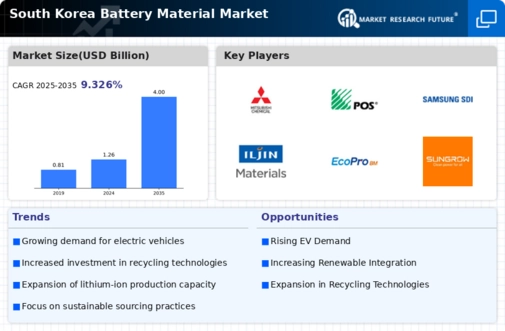The South Korea Battery Material Market is characterized by a dynamic competitive landscape fueled by the rapidly evolving demands of technological advancements and the global shift towards sustainable energy solutions. The market is driven by the growing electric vehicle sector, renewable energy storage applications, and the increasing need for consumer electronics, which has prompted companies to innovate and enhance their product offerings. Key players are investing in research and development to create high-performance materials, seeking to secure their positions in a market that is witnessing substantial investments and strategic mergers and acquisitions.
The competitive insights highlight the importance of technology, supply chain management, and strategic partnerships as companies endeavor to outperform one another and meet rising consumer expectations within this pivotal market. Solus Advanced Materials has established a formidable presence in the South Korea Battery Material Market, primarily focusing on producing advanced materials for lithium-ion batteries. The company is recognized for its strong emphasis on innovation, developing cutting-edge materials that enhance battery performance and energy density, crucial for the growing electric vehicle market.
The strength of Solus Advanced Materials lies in its robust research and development capabilities, which enable it to stay ahead of competitors by continually introducing new solutions tailored to the demands of battery manufacturers. Furthermore, strategic collaborations with key players in the electronics sector bolster its market position, allowing the company to expand its reach and improve its standing in a competitive environment characterized by rapid technological changes. Nippon Steel Chemical plays a significant role in the South Korea Battery Material Market, focusing on supplying high-quality materials such as cathodes and anodes for battery applications.
The company has developed key products that cater to the evolving needs of battery manufacturers, particularly in the electric vehicle sector. Nippon Steel Chemical is renowned for its strong market presence in South Korea, supported by advanced manufacturing processes that ensure the consistency and reliability of its products. The company’s strengths also include its commitment to sustainability, with ongoing research directed towards developing eco-friendly battery materials. Mergers and acquisitions have bolstered its capabilities, allowing for diversification and enhanced market competitiveness.
With a strategic focus on innovation and collaboration, Nippon Steel Chemical continues to strengthen its foothold within the dynamic landscape of battery materials in South Korea.






















Leave a Comment